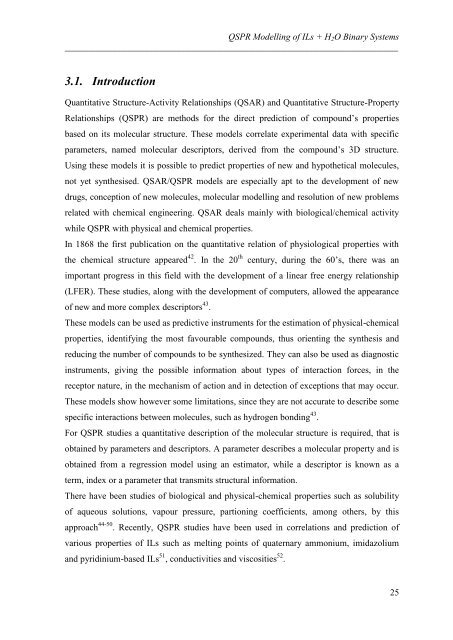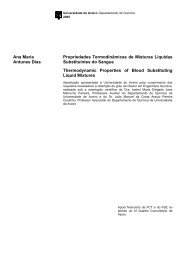Catarina Maia Seco Seiça Neves Sistemas Aquosos Bifásicos com ...
Catarina Maia Seco Seiça Neves Sistemas Aquosos Bifásicos com ...
Catarina Maia Seco Seiça Neves Sistemas Aquosos Bifásicos com ...
Create successful ePaper yourself
Turn your PDF publications into a flip-book with our unique Google optimized e-Paper software.
QSPR Modelling of ILs + H2O Binary Systems<br />
_________________________________________________________________________<br />
3.1. Introduction<br />
Quantitative Structure-Activity Relationships (QSAR) and Quantitative Structure-Property<br />
Relationships (QSPR) are methods for the direct prediction of <strong>com</strong>pound’s properties<br />
based on its molecular structure. These models correlate experimental data with specific<br />
parameters, named molecular descriptors, derived from the <strong>com</strong>pound’s 3D structure.<br />
Using these models it is possible to predict properties of new and hypothetical molecules,<br />
not yet synthesised. QSAR/QSPR models are especially apt to the development of new<br />
drugs, conception of new molecules, molecular modelling and resolution of new problems<br />
related with chemical engineering. QSAR deals mainly with biological/chemical activity<br />
while QSPR with physical and chemical properties.<br />
In 1868 the first publication on the quantitative relation of physiological properties with<br />
the chemical structure appeared 42 . In the 20 th century, during the 60’s, there was an<br />
important progress in this field with the development of a linear free energy relationship<br />
(LFER). These studies, along with the development of <strong>com</strong>puters, allowed the appearance<br />
of new and more <strong>com</strong>plex descriptors 43 .<br />
These models can be used as predictive instruments for the estimation of physical-chemical<br />
properties, identifying the most favourable <strong>com</strong>pounds, thus orienting the synthesis and<br />
reducing the number of <strong>com</strong>pounds to be synthesized. They can also be used as diagnostic<br />
instruments, giving the possible information about types of interaction forces, in the<br />
receptor nature, in the mechanism of action and in detection of exceptions that may occur.<br />
These models show however some limitations, since they are not accurate to describe some<br />
specific interactions between molecules, such as hydrogen bonding 43 .<br />
For QSPR studies a quantitative description of the molecular structure is required, that is<br />
obtained by parameters and descriptors. A parameter describes a molecular property and is<br />
obtained from a regression model using an estimator, while a descriptor is known as a<br />
term, index or a parameter that transmits structural information.<br />
There have been studies of biological and physical-chemical properties such as solubility<br />
of aqueous solutions, vapour pressure, partioning coefficients, among others, by this<br />
approach 44-50 . Recently, QSPR studies have been used in correlations and prediction of<br />
various properties of ILs such as melting points of quaternary ammonium, imidazolium<br />
and pyridinium-based ILs 51 , conductivities and viscosities 52 .<br />
25



